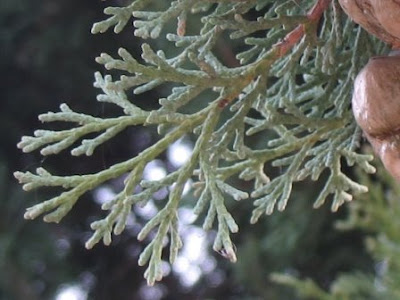 The Mediterranean Cypress tree (species: Cupressus sempervirens) is known by many common names which include; Common Cypress, Italian Cypress, Graveyard Cypress, Tuscan Cypress, Funeral Cypress, Pencil Pine or Spanish Cypress. The Latin name "sempervirens" can be divided into two parts "semper" - always or ever and "virens" - green. Thus the term can be translated as "evergreen".
The Mediterranean Cypress tree (species: Cupressus sempervirens) is known by many common names which include; Common Cypress, Italian Cypress, Graveyard Cypress, Tuscan Cypress, Funeral Cypress, Pencil Pine or Spanish Cypress. The Latin name "sempervirens" can be divided into two parts "semper" - always or ever and "virens" - green. Thus the term can be translated as "evergreen".The Mediterranean Cypress tree is similar to the "Cedar of Lebanon" in that there are references to it that reach as far back as the Greek mythologies. Cyparissus is a mythical figure who was a friend of the Greek god Apollo. According to the myth Cyparissus was transformed by Apollo into a Cypress tree so that he could forever mourn the death of a dear stag that he had slain. Notice the close resemblance between the name "Cyparissus" and the name of the genus "Cupressus".
As can be deduced from several of the common names of this tree species the "Graveyard" or "Funeral" Cypress is closely associated with cemeteries and mourning. This can possibly be traced back to the Greek myth of Apollo and Cyparissus but the truth of the matter is that many cemeteries in Southern Europe are graced with these trees. The Cypress and the Yew are by far the most common trees in Mediterranean cemetaries.
The Mediterranean Cypress has been cultivated as an ornamental tree for thousands of years. It was the Romans who began to spread the cultivation of this tree throughout the Roman empire. It was prized for its columnar shape (although this tree species is not always straight and thin). It is also the source of strong durable wood that was used by the Phoenicians and Cretans used the wood for building ships and by the Egyptians who used it to make sarcophagi.
Cypress oil has a woody, slightly spicy and refreshing masculine smell. The oil is colorless to very pale yellow in color and watery in viscosity.
The Island of Cypress derives its name from this tree and according to at least one legend the Cross the Jesus was crucified on was made of the wood of the Mediterranean Cypress.

Bark of a mature Cypress tree
This tree species is also used in the cultivation of Bonsai trees.

Bonsai Garden Secrets
"Bonsai Gardening Secrets" is an easy to understand quick-start guide that'll show you how to create stunningly beautiful Bonsai trees


















































